Racial Justice Sunday
The theme for Racial Justice Sunday is: “Seeing one another in the life of the Church”.
It is important to recognise that we are all children of God, regardless of our race and background. This year’s theme seeks to promote reflection, discussion and action on our theme and to encourage us to carry this through in the weeks and months after Racial Justice Sunday.
Bishop Paul McAleenan, Lead Bishop for Racial Justice, offers a short message for Racial Justice Sunday.
For this year’s resources, we are celebrating the diversity of those who have led holy and exemplary lives. Our Catholic saints walked in this world as we do and were men and women of heroic virtue that can intercede for us to bring our prayers to the Lord.
Men and women of historic virtue have walked the path to sainthood for centuries, inspiring us to look to their example and pray to them to take our petitions to the Lord. However, when you look at the prayer cards and icons for sale in our parish shops and kiosks, you could be forgiven for thinking that all our saints are white Europeans.
This, of course, only reveals a segment of the bigger picture, and there are many saints of colour in the Catholic Church who have inspired the faithful in their devotions.
In this section, we celebrate just a few of these men and women – some already canonised, others on the path to sainthood as Venerable or Blessed.
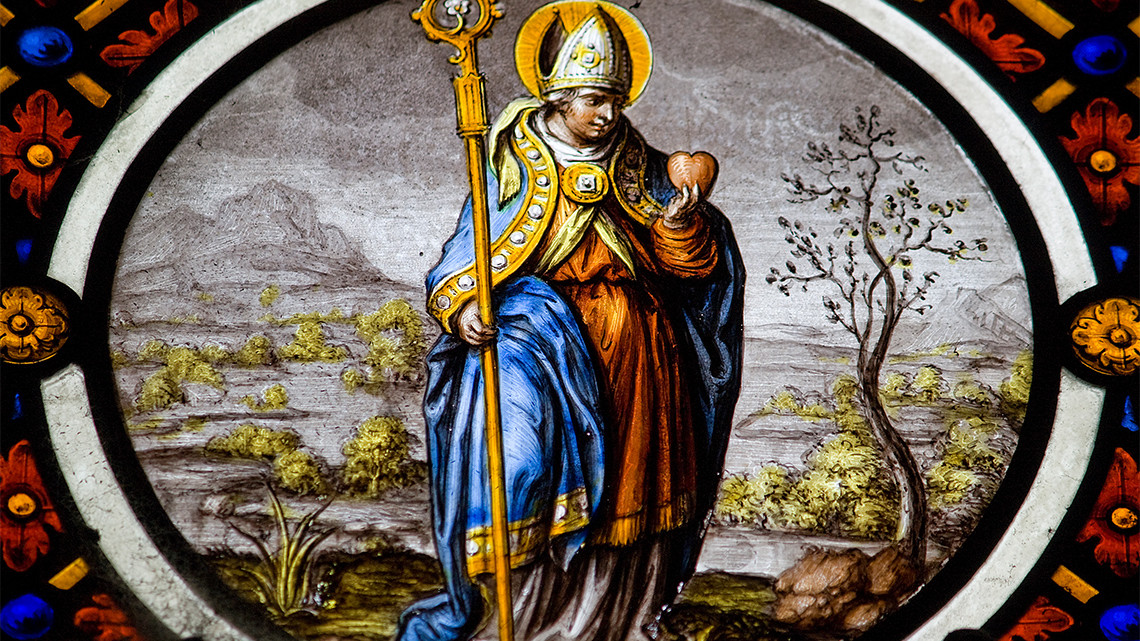
St Augustine of Hippo was a philosopher, theologian, and graced author who was of Berber origin and a native of Tagaste in present-day Algeria, North Africa.
Born to a pagan father and a devout Catholic mother, St Augustine’s teenage years embodied the rebellion during which he abandoned his faith, stayed away from home to avoid his mother’s relentless admonitions, and even fathering a child outside marriage.
Despite being recognized a brilliant teacher of oratory by the Roman emperor at the time and appointed to teach in Milan, St Augustine was restless. He was at the peak of his career and had everything working for him, yet he yearned for something more. This longing led him to the Manichean cult and later to Hellenistic philosophy. However, the preaching of St Ambrose, bishop of Milan, would flood his mind and intellect with the light, eventually putting his blindness to flight.
St Augustine accepted baptism in AD 386, renouncing his old life: job, mistress, and the city of Milan. He embraced the life of service to God as a priest and later Bishop of Hippo, a little coastal town in North Africa.
Many years after his conversion experience, St Augustine would write his Confessions: an autobiography in which he bares it all, hiding nothing of who he had been. Bemoaning his late discovery of the unending peace, love and joy that can only come from fully embracing the life of grace that faith in our loving God affords us. He wrote:
Late have I loved you, beauty so old and so new: late have I loved you. And see, you were within, and I was in the external world and sought you there, and in my unlovely state, I plunged into those lovely, created things which you made. You were with me, and I was not with you. The lovely things kept me far from you, though if they did not have their existence in you, they had no existence at all. You called and cried out loud and shattered my deafness. You were radiant and resplendent, you put to flight my blindness. You were fragrant, and I drew in my breath and now pant after you. I tasted you, and I feel but hunger and thirst for you. You touched me, and I am set on fire to attain the peace which is yours (Confessions X.xxvii.38).
Reflection
By Sr Vivian Onyeneho, Handmaids of the Holy Child Jesus
St Augustine’s story demonstrates the whirlwind ride through life in search of the Truth and the redemptive power of God’s love.
His many writings and teachings earned him the honour of being a Doctor of the Church, but his Confessions is a classic story that every restless soul can identify with. He remains a symbol of true repentance and freedom that comes with realising that we are known and loved.
Our true identity lies in God. Coming to this knowledge alone can be the much-needed antidote for many facing identity crises in today’s world. Book clubs in our Catholic schools or faith-based classical studies on the life of St Augustine could prove effective in leading people, young and old, to recognise their restlessness, ask the right questions, and hopefully forge their pathway back to the place of rest, in the heart of our Creator.
As St Augustine once noted: “Thou hast made us for thyself, O Lord, and our heart is restless until it finds its rest in thee.” This eternal Truth, so well-articulated, is the guiding compass in my life’s quest for lasting love, peace, and joy. More so, what inspires me the most is St Augustine’s sheer humility in disclosing his faults. His confessions speak to people throughout history and remain relevant today.
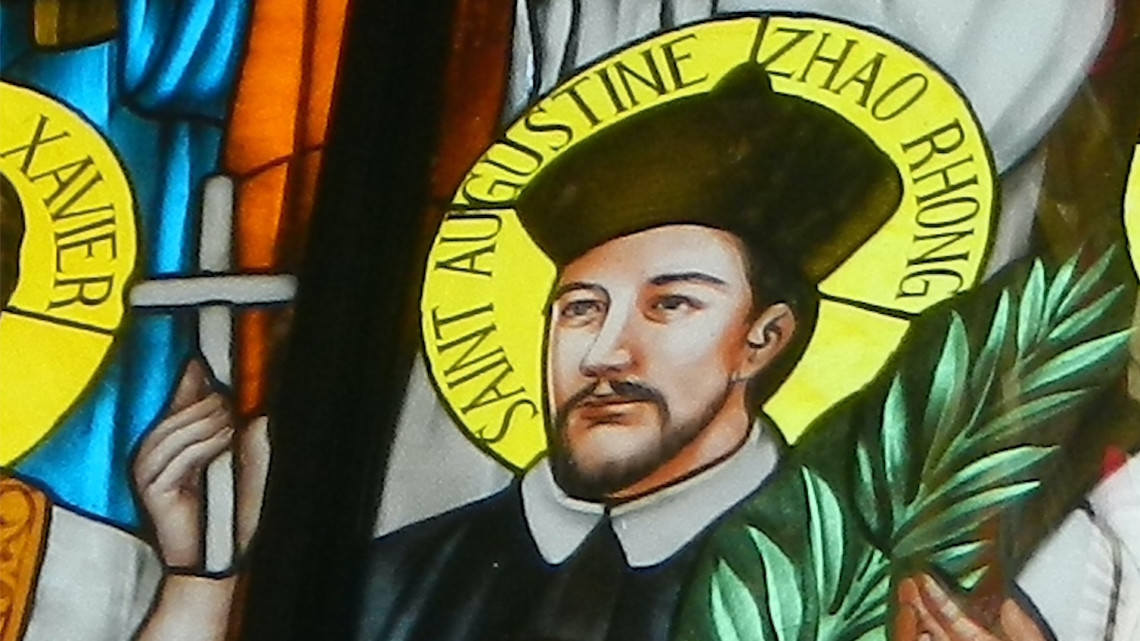
St Augustine Zhao-Rong, originally surnamed Zhu, was born in 1746 in Wu Chuan, Guizhou Province. When he was nearly 20, while serving as a sergeant in Wu Chuan County, he encountered Christianity during its introduction from Sichuan.
Persecution of Christianity began in 1748 during the reign of the Qianlong Emperor, leading to the arrest of many Christians, including a priest called Father Mei. Zhu Rong was moved by the teaching of Father Mei, and Zhu Rong quickly embraced Christianity and deepened his understanding of the faith. In 1752, on St Augustine’s feast day, Father Mei baptized and confirmed Zhu Rong, giving him the name Augustine. Recognising Zhu Rong’s strong faith, Father Mei entrusted him with various tasks, teaching him Latin and encouraging the study of books about the saints.
Impressed by Zhu Rong’s loyalty and enthusiasm, another priest, Father Lou, sought his assistance. Recognising his outstanding faith, Father Lou appealed to the bishop for Zhu Rong’s ordination as a priest. At the age of 35, Zhu Rong became a priest, adopting the surname Zhao and so from then on was called Zhao Rong.
Later, the bishop assigned him to care for all Catholics in the three counties of Guan Xian, Jin Tang, and Wen Jiang in western Sichuan Province. Zhao Rong tirelessly taught, zealously preached, devotedly fulfilled his duties, and heard confessions with care. In the 1815, during the reign of the Jia Qing, as Christian persecution began again, Father Yang urged him to leave the region, but being old and frail, Zhao Rong explained his inability to escape. He asked Father Yang to pray for his perseverance, courage, and steadfastness.
One day a gangster questioned Zhao Rong about his belief in Catholicism. Zhao Rong replied that he not only believed in the Catholic Church, but that he also was a leader in the Church. The bandit reported him to state officers, leading to his arrest and subsequent transfer to Chengdu, the capital of Sichuan. In prison, Zhao Rong endured various forms of abuse.
One day, officials pressured him to renounce Jesus, but Zhao Rong firmly replied, “I am willing to accept all kinds of punishments, but the one thing I cannot do is abandon my Lord Jesus Christ.”
In prison the official ridiculed him in every possible way and ordered the prison officer to beat him. Zhao Rong was kept in prison to await his final judgement, but, due to his old age and inability to endure punishment, he died in prison. Then the officers buried him in Guan Shan. In 1822 Zhao Rong was moved to Feng Huang Mountain in Guangdong Province. On 27 May 1900 Pope Leo XIII declared Zhao Rong Blessed, and on 1 October 2000, Pope John Paul II canonised him as a saint together with 120 other Chinese martyrs.
The Universal Church commemorates the feast of St Zhao Rong and Companions (Chinese Martyrs) on the 9 July of each year, though the Church in China observes his feast day on 27 January.
St Zhao Rong, pray for us!
Reflection
By Fr. Joseph Liang
As I prepared, a week or so ago, a simple biography of the Chinese priest St Augustine Zhao Rong, martyred in 1815, his life inspired me on how to live out my vocation as a Chinese priest today.
St Augustine Zhao Rong’s unwavering loyalty to his vocation serves as a poignant reflection on commitment and sacrifice. Despite facing persecution and challenges, he remained steadfast in his calling as a Christian and a priest. This challenges me to contemplate my own vocation and commitment since receiving the ordained priesthood during my ordination. As a priest, I have already made a commitment to love the Lord and serve the Church.
This commitment is not just for a number of months or years, but is a lifelong dedication to the vocation of the priesthood. While I can keep my loyalty and enthusiasm for a few years, the real test is whether I can maintain it for my entire life. We know there are many temptations around, capable of attracting my attention and diminishing my energy.
Every year, as I celebrate the feast of St Augustine Zhao Rong and the Chinese Martyrs, I am urged to stay true to my principles even when faced with difficulties. St Zhao Rong’s life invites me to ponder the depth of my dedication to my chosen path, inspiring me to persevere in my vocation with a sense of purpose and fidelity.
St Zhao Rong encountered challenges during his life, yet his enduring faith remained unshaken. I acknowledge that I have faced my own trials in my priestly life. When I look back at the journey of my life, I truly have to give thanks to the Lord. It is the transformative power of enduring faith in God that made me strong, enabling me to stand with the Lord and navigate the complexities of my own journey with trust and perseverance.
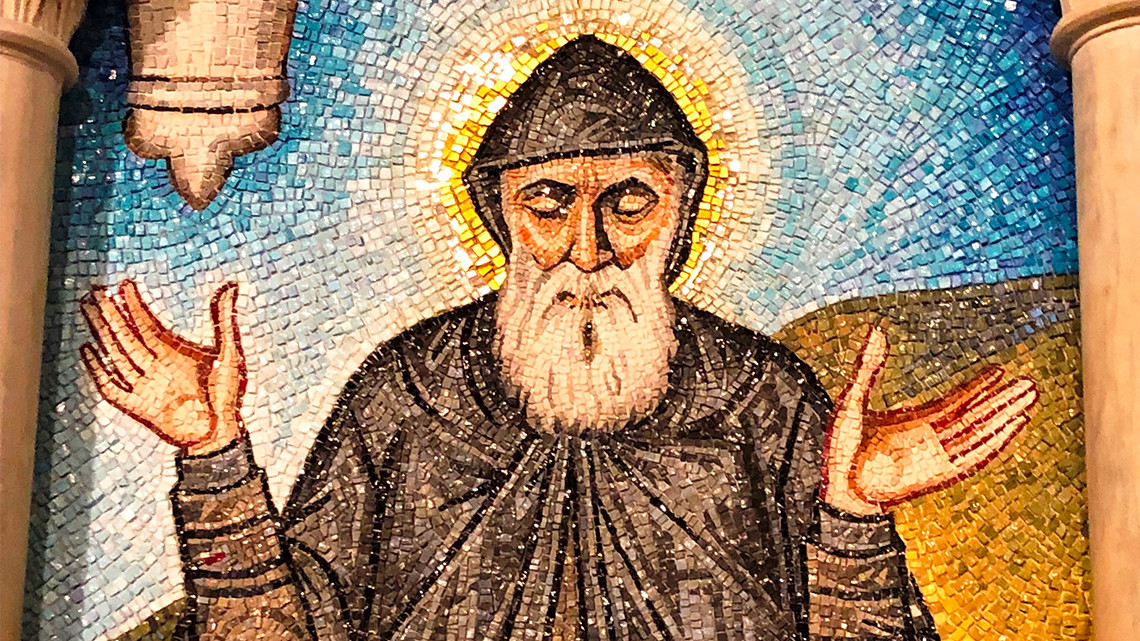
A Lebonese Maronite, St Charbel is known for both his holiness and his ability to unite Christians, Muslims and Druze.
Youssef Makhlouf was born in the year 1828 in the mountainous village of Bekaa’kafra – said to be the highest village in Lebanon. It was an arena of conflict between the Ottomans and the Egyptian army at the time. The resources of the land were pillaged, homes were confiscated and villagers taken way for forced labour. At a very young age, Youssef himself experienced the loss of his father who died while returning from Corvée in the Turkish forces – an unpaid, forced labour.
At the age of 23, Youssef joined the Lebanese Maronite Order, entering first the monastery of Our Lady of Mayfouq, followed by the monastery of Saint Maroun, Annaya. He took the name Charbel, and after professing his vows, he continued his studies in the monastery of Kfifan. He was ordained a priest in 1859.
A year later, while Father Charbel was a monk in the monastery of Saint Maroun, Annaya, Mount Lebanon was experiencing deadly civil war. This affair led to the martyrdom of forty monks from the Lebanese Maronite Order. Despite the death of his brother monks, Father Charbel remained persistent in his prayers, in his devotion to his vows and in his spiritual growth. This led him to enter the hermitage in the year 1875.
In the last quarter of the nineteenth century, while Father Charbel was living in the hermitage, Mount Lebanon experienced the worst crisis in the 19th century. Unable to compete with Chinese silk which flooded the European market at the time, the Lebanese economy was hit with what was known as the ‘Silk Crisis’, forcing thousands of families to emigrate to Americas. Among those who emigrated to Mexico were Saint Charbel’s brothers. Yet again, the hermit Father Charbel was faced with the pain of losing his family and loved ones.
On 16 December 1898, while celebrating Holy Mass, Father Charbel was struck with hemiplegia. He spent the next eight days in excruciating pain. His only weapon was prayer, and he persisted in his prayers until he died on the night of Christmas Eve of that same year.
Saint Charbel was buried in the monastery’s burial grounds, but there were few who attended his burial due to the absence of the monks who had gone to the funeral of the Maronite Patriarch Youhanna Al-Hajj.
Reflection
By Fr Fadi Kmeid OLM
Today, we are encountering times of great change in our societies, and even more so from a religious aspect. Today, and for many, it is difficult to find God. Societies no longer depend on the will of Our Father, but on fate and destiny. The world is not as we knew it, and once more we find ourselves longing for that glorious time that was the time of the Saints. We fall victim to that state of yearning and nostalgia whenever our memories recall decisions of the past which, though may not have been without their flaws, still leave us with the marks of great and joyful experiences.
The current changes in our society have fittingly driven me to find out more about that time, especially the historical, social, and political conditions in which Saint Charbel lived and was sanctified, so that maybe we can benefit from the past in order to understand the present.
Saint Charbel is one of those brilliant pages in the history of our Maronite faith, church and our homeland, Lebanon. He lived seventy years of ongoing problems and struggles on this earth and was an example of commitment and stability in God. He never once went astray from his monastic vows. He did not lose his hope in God the Father, the Son, and the Holy Spirit, and thus he reached in his lifetime the height of Christian life and unity with God.
Charbel’s message to us, today, is not only a message of trust in a God who defeated sin, the devil and death, but also a message of holiness, and of hope in our Lord God Jesus Christ who says: “Come to me, all who labor and are heavy laden, and I will give you rest” (Mt. 11:28).
No matter how much time has passed and regardless of how much it has changed, the time of the Saints is here, today, just as it was yesterday.
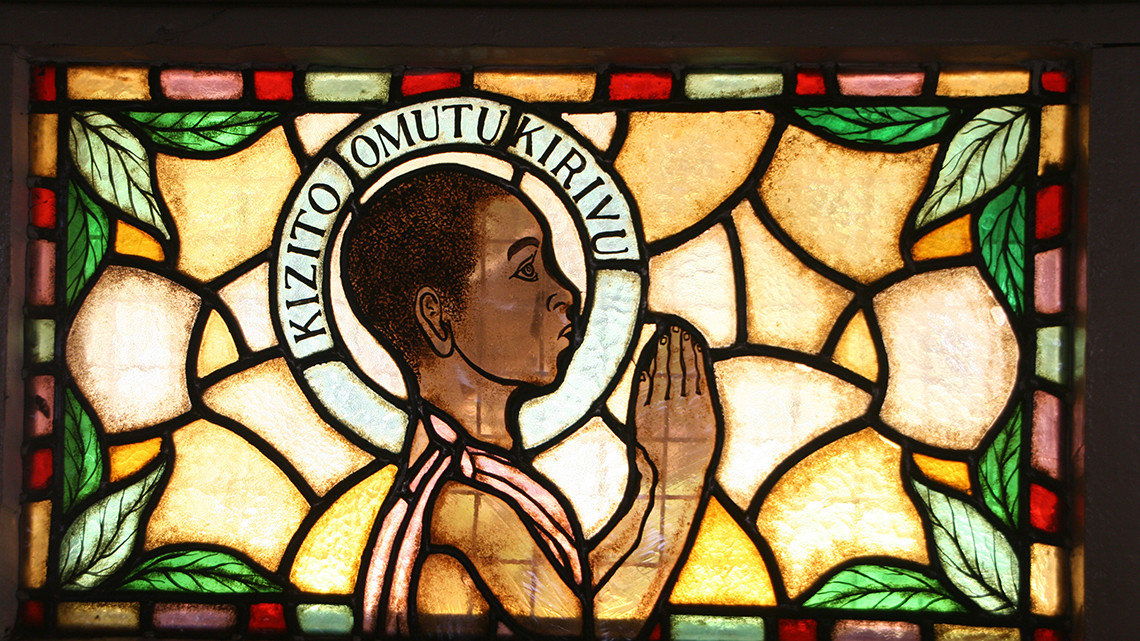
Kizito was born around 1872 in the small village of Waluleta, central Uganda to a non-Christian family. Due to his friendly, witty and hard-working attributes, he was selected to work as a royal page in the apartment of King Mwanga II.
Despite the King’s demands for all Christians to renounce their faith or face death, Kizito became a passionate student of the faith and took every opportunity to beg the local priests to baptise him. Fearing Kizito might be killed on duty, he was persistently refused baptism on the grounds that he was simply too young and lacking instruction. However, when the persecution of Christians began in Uganda, he was finally baptised on 25/26 May 1886 by Charles Lwanga, the leader of Uganda’s Christian community at the time, and took the name, John the Baptist.
However, a day after, despite Lwanga’s advice to all palace children to run and hide from Christian prosecutors, Kizito refused to go. He was burnt alive alongside Lwanga on 3 June 1886 in Namugongo. His last words were “Goodbye friends, we are on our way.” At the age of fourteen, Kizito became the youngest of the 22 Ugandian martyrs killed by the King.
He was beatified by Pope Benedict XV in 1920 and canonised by Pope Paul VI on 18 October 1964. He is the patron saint of children and primary schools.
Reflection
By Father Samuel Ofia, Missionary Society of St Paul
It is very inspiring that an African child of only 14 years can stand and oppose the King in defence of his Catholic faith. In a culture where children are only seen but not heard, St Kizito has become the model for all children.
Let us pray:
God of infinite goodness, you said that children should be allowed to come to you. We pray for children all over the world, especially for those in danger. That through the intersession of St Kizito, you will give voice to the voiceless and protection to our children, through Christ or Lord, Amen.

Who will ever forget the gruesome and brutal executions of 21 construction workers perpetrated by Islamic State terrorists on a beach in Libya in February 2015? Filmed for a propaganda video, the men were dressed in identical orange jumpsuits and were led along a beach by black-clad militants before being murdered – many praying as they were martyred.
Matthew Ayariga was one of the men. The other workers were identified as Coptic Orthodox Christians, but Ayariga presence among them is something of a mystery. Some speculate that he was a Catholic. In the time before his death, when he was questioned by his terrorist captors, he simply said “their God is my God.”
Days after the murders, the martyrs were Canonised by Coptic Orthodox Pope Tawadros II. Pope Francis followed suit announcing that the 21 men would “be included in the Roman Martyrology as a sign of the spiritual communion uniting our two Churches”.
It is believed that Matthew Ayariga was born in Ghana, or possibly Chad, in the late 80s or early 90s. Not much is known about him but he evidently left his homeland to earn a living as a migrant worker. In 2015 he sought construction work in the Libyan port town of Sirte.
Matthew Ayariga’s willingness to die alongside his Coptic companions is why we celebrate him as a saint and martyr. As Pope Francis said: “These martyrs were baptised … in blood, blood that is a seed of unity for all followers of Christ.”
Reflection
By Father Mark E. Odion MSP, Policy and Research Analyst at the Bishops’ Conference.
“Matthew Ayariga was a man who was not afraid to identify with Christ. He stands for courage. He inspires me to be open in professing my faith.
“From his life, I see a man who joyfully stood for what he believed. He was not ashamed and publicly proclaimed his faith in the face of death.”
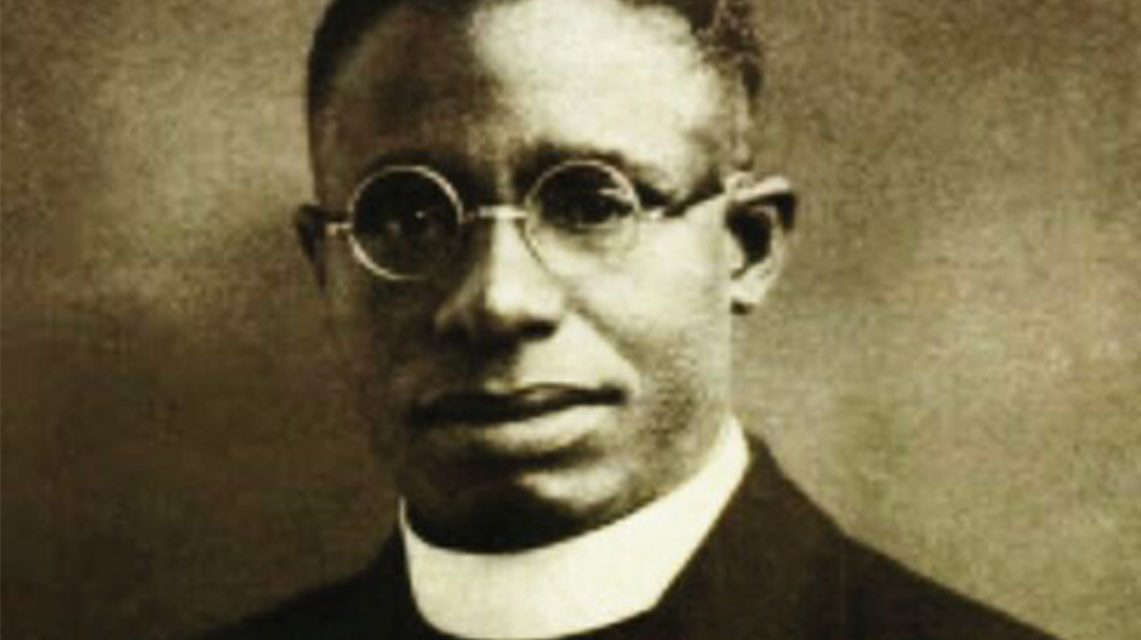
Blessed Michael Cyprian Iwene Tansi was born in the village of Igboezunu – Aguleri, Nigeria, West Africa in September 1903.
Blessed Michael Cyprian Iwene Tansi was born in the village of Igboezunu – Aguleri which is
situated around the south-eastern geopolitical zone of Nigeria, West Africa in the present day
Anambra State in September 1903.
Tradition has it that, Blessed Michael Cyprian Iwene Tansi was born into a non-Christian
family and got baptised with the name Michael, when he was barely 10 years of age since he
was opportune to attend a catholic school where he learnt more about Jesus Christ. He is often
identified as Father Michael Iwene Tansi.
Father Michael Iwene Tansi first served the Catholic Church after his baptism as a catechism
instructor where he taught the catholic faith to those who were to be baptised as Catholics.
Through this experience of teaching catechism, he developed his career of educating young
men and women around his village. After some time, he went ahead to train for the catholic
priesthood and was ordained at the age of 34 years. Father Michael Iwene Tansi did his priestly
ministry in mostly eastern communities around Anambra State.
Indeed, Father Michael Iwene Tansi is most times celebrated for his strong dedication to his
local community and his strong devotion to the Christian faith which he processed right from
his conversion to Christendom.
In performing his priestly ministry, Father Michael Iwene Tansi would often travel to
evangelize the neighbouring village communities. This he did with his bicycle as means of
transportation and sometimes on his foot. He spent most of his time visiting the sick people in
the village, the poor and the unloved in the communities where he ministered.
Father Michael Iwene Tansi later on in his life time sought permission to become a member of
the Trappist monastery officially known as Cistercians Monks of Strict Observance of Mount
St Bernard Abbey in Leicestershire in England. As he remained a monk, he was renamed
Cyprian and his desire was to be able to open a Cistercian monastery in Nigeria in the years he
lived which he could not actualise. Although, he was later commissioned to establish a
Cistercian monastery in neighbouring Cameroon, even though his health deteriorating did not
allow this to materialise.
Father Michael Iwene Tansi died at the age of 61 years and in 1986, his remains was moved
from the Cistercian Monastery of Mount St Bernard Abbey in Coalville – Leicestershire to
Nigeria for burial. Then, on 22nd March of 1998, Father Michael Iwene Tansi was beatified by
Pope John Paul II in a ceremony which was held in Onitsha located in present day Anambra
State. The Pope John Paul II declared January 20th as a day reserved to celebrate his feast since
he died on this day in 1964. His relics is situated in the Cathedral Basilica of the Most Holy
Trinity in Onitsha Archdiocese, Anambra State, Nigeria, West Africa.
Reflection
By Father Paul Ubebe, Priest of the Congregation of the Oblates of the Virgin Mary
The figure of Father Michael Iwene Tansi challenges me to be dedicated to the priestly responsibility I have embraced, and the willingness to make sacrifices in propagating the faith I profess wherever I find myself as a missionary.
Mainly Father Michael Iwene Tansi remains a daily inspiration not only for me, but for those who study his life. In fact, his dedication to reduce the barrier of distance in preaching the Word of God is a strong motivation.
On another note, the personality of Father Michael Iwene Tansi has taught me, over the years, to remain resilient in proclaiming and teaching the Catholic faith – not only in my locality but to carry the mission of Christ across borders.
Most importantly, Father Michael Iwene Tansi should be an inspiration to many for his deep sense of humility and dedication to evangelisation. He was also dedicated to helping the poor and marginalised in his community.
On a final note, Father Michael Iwene Tansi is often invoked as the patron of those seeking a strong and deep faith in God.

Oscar Romero, the Archbishop of San Salvador, was deeply motivated by his faith to speak out and act for human rights and social justice, knowing that this brought risks to his own safety. Born on 15 August 1917 in El Salvador, Romero’s life unfolded against the backdrop of a country grappling with social inequality and political turmoil. It was during his time as Archbishop from 1977 to 1980 that St Romero was steadfast in championing the rights of the marginalised in El Salvador and he spoke out against those who committed terrible acts of violence.
He underwent a spiritually profound change when confronted with the harsh realities of the majority of people in El Salvador. There was brutal suppression of dissent by the authorities at the time and a widespread violation of human rights. Romero began to view his role not merely as a spiritual leader but as a “voice for the voiceless”. He once said:
“Each time we look upon the poor, on the farmworkers who harvest the coffee, the sugarcane, or the cotton… remember, there is the face of Christ.”
In terms of Christian faith, Romero’s significance lies in his resolute defence of the Church’s teachings on human dignity and the preferential option for the poor. In a society marked by deep divisions, Romero consistently spoke out against discrimination and violence, emphasising the inherent dignity of every individual, regardless of their background.
Every Sunday his sermon was broadcast by radio and the whole country listened. Romero was a CAFOD partner and when his radio station was bombed, CAFOD helped rebuild it.
In his sermon on 23 March 1980, Romero ordered the army to stop killing people:
“In the name of God, and in the name of this suffering people whose cries rise to heaven more loudly each day, I beg you, I implore you, I order you, in the name of God, stop the repression!”
The next day, he was assassinated while celebrating Mass. He was canonised by Pope Francis in 2018, and is known as a martyr for justice and a beacon of hope for those striving to create a more inclusive society.
Reflection
By Deborah Purfield, CAFOD
Oscar Romero’s life is an inspiration and a challenge for us to engage actively in the pursuit of justice and to uphold the dignity of every human being. He imitated His Lord Jesus Christ so closely and was “God-with-skin-on” for his people and for us today.
Even though he knew his days were numbered, it did not silence his message :
“If you kill me, I will rise again in the Salvadoran people.”
This powerful statement reflects Romero’s profound conviction that his commitment to social justice and the defence of the marginalised would endure beyond his physical life. We are invited to examine our own commitment to justice, compassion, and the transformative power of the Gospel in the world today.

Credited as the founder of Catholic Charities New York, Venerable Pierre Toussaint was a model of selflessness whose life’s work was to help others.
Toussaint was born into slavery on the island of Haiti in 1766. His slave master, Bérard, fleeing the Haitian revolution, brought him to New York City where he first worked as a barber. Bérard allowed him to keep much of his earnings from being hired out. Toussaint made a good living as a popular hairdresser among New York’s elite and chose to use his wealth to fund many acts of charity, such as sheltering orphans, nursing the sick, restoring St Peter’s Church after a fire and helping to finance the construction of St Patrick’s Old Cathedral. He also organised a credit bureau, an employment agency, and a refuge for priests and travellers.
In 1968, in recognition of his virtuous life, the then-Cardinal Archbishop of New York introduced Toussaint’s cause for canonisation at the Vatican. A year later, Cardinal O’Connor had his remains transferred from Lower Manhattan to St. Patrick’s Cathedral in midtown Manhattan, where he is buried as the only layperson, alongside the former Cardinal-Archbishops of New York City.
On 17 December 1997, Pope John Paul II declared Pierre Toussaint ‘Venerable’, placing him firmly on the path to becoming North America’s first black saint.
Venerable Pierre Toussaint was a man who was proud of his faith and culture, and was committed to serving others.
Reflection
By Father Mark E. Odion MSP, Policy and Research Analyst at the Bishops’ Conference
“Venerable Pierre Toussaint was a man who dedicated his life to serving other people. He was a selfless man who gave without counting the cost.
“Venerable Pierre Toussaint inspires me to be generous in my everyday practice to those in need, and to be open to support the less privileged in our society. He has taught me the act of generosity and selfless service to the vulnerable. From his life, one can learn that no act of kindness goes unrewarded.”
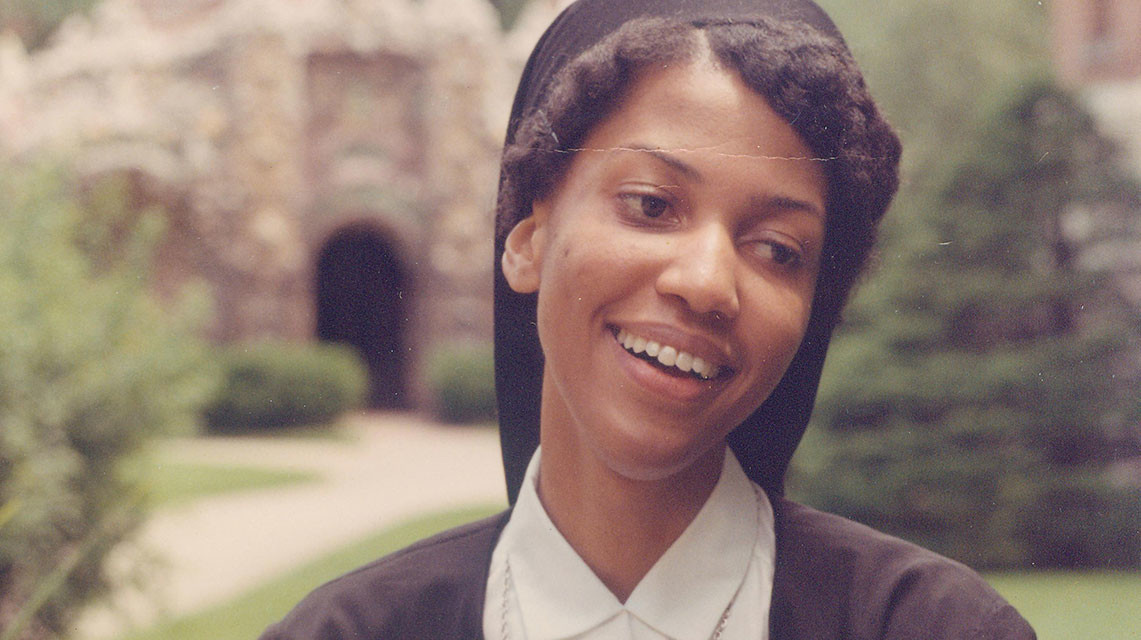
Born on 29 December 1937 in Yazoo City, Mississippi, Thea was raised a Protestant until the age of nine when she asked her parents if she could become a Catholic. She enrolled in a Catholic School, which deepened her appreciation for the Catholic faith.
When she was fifteen, she overcame her parents’ objections to travel north to Wisconsin to join the Order of the Franciscan Sisters of Perpetual Adoration in La Crosse. The granddaughter of slaves, she was the only African American member of the religious community, and she transcended racism to leave a lasting mark on US Catholic life in the late 20th century.
Sister Thea was a bridge builder who upheld civil rights and worked diligently to heal a people wounded by segregation and slavery. The social structures prevented the marginalised black population from feeling welcome in a Church that they saw as a Church of white people. Through teaching and sharing the message of God’s love, Sister Thea played a crucial role in bridging the ethnic gap within the Church in Mississippi.
After 16 years of teaching, the Bishop of Jackson invited Sister Thea to become the consultant for intercultural awareness, where she would create programs directed to break down racial and cultural barriers. Sister Thea encouraged people to communicate with one another to understand other cultures and races, which was no small task at the given time.
In 1984, Sister Thea was diagnosed with breast cancer. She prayed “to live until I die.” Her prayer was answered, and Thea continued her gatherings seated in a wheelchair.
In 1989, the U.S. bishops invited her to be a key speaker at their conference on Black Catholics. At the end of the meeting, at Thea’s invitation, the bishops stood and sang “We Shall Overcome” with gusto.
Thea lived a full life and fought evil, prejudice, suspicion, hatred and the things that drive people apart. She fought for God and God’s people until her death in 1990.
Sister Thea’s cause for canonisation was opened and supported by the US bishops in 2018.
Photo credit: Franciscan Sisters of Perpetual Adoration
Reflection
By Father Mark E. Odion MSP, Policy and Research Analyst at the Bishops’ Conference.
“Sister Thea Bowman stood as a champion of faith uniting the wounded black Americans with the Catholic Church. She is the bridge of unity and peace in the divided church, and the face of welcome to the black community in her society.
“Sister Thea Bowman inspires me to always work towards breaking down racial and cultural barriers in our society, to always be welcoming to all people. She has taught me to stand for unity in the practice of faith with others and to see Christ in everybody. We can learn from her that there is strength and joy in unity and peace.”
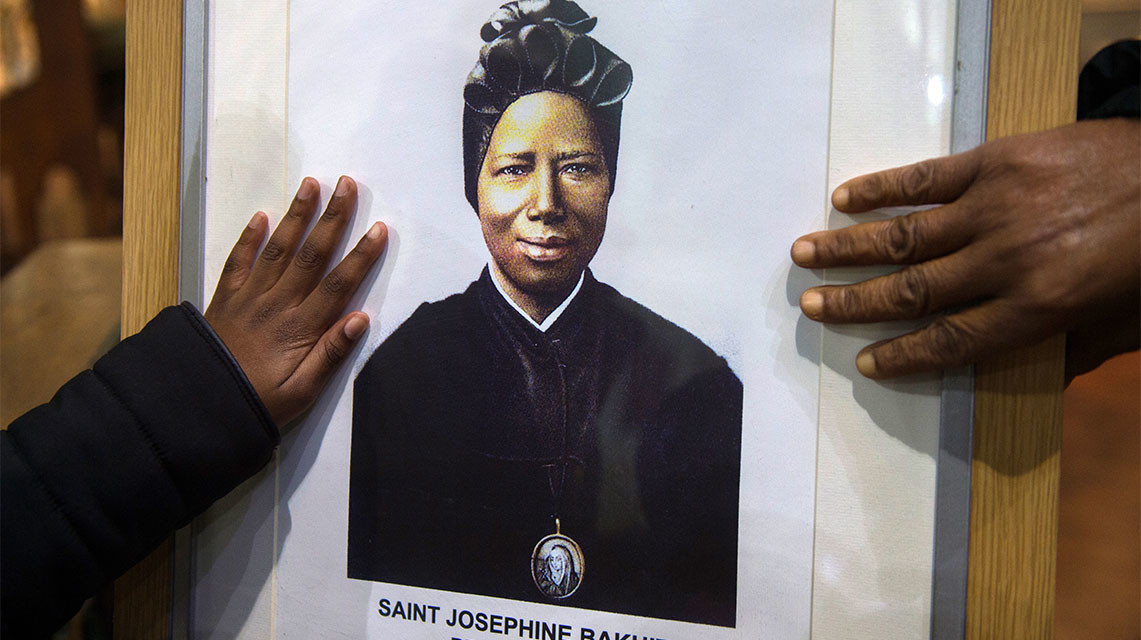
Saint Josephine Margaret Bakhita was born in 1869 in the village of Olgossa in the Darfur region of Sudan.
Around February 1877, Arab slave traders kidnapped Bakhita and, during her time in captivity, she lived a life of immense suffering. On one occasion, she as forced to walk barefoot over 600 miles to a slave market in El Obeid, where she was sold at least twice during the gruelling journey.
After several years of slavery and abuse, Bakhita was placed in the custody of the Canossian Daughters of Charity, the Canossian Sisters, in Venice. It was here that Bakhita came to learn about God. She was deeply moved by her time with the sisters and discerned a call to follow Christ.
When speaking of her enslavement, Bakhita said she would often thank her kidnappers – had it not been for her kidnapping, she may never known the love of Jesus Christ.
Bakhita is a symbol of endurance and the power of faith. Saint Josephine Bakhita is the patron saint of Sudan, and her feast day is celebrated on 8 February.
In 1958, Josephine Bakhita’s process of canonisation began for under Pope John XXIII. On 1 December 1978, Pope John Paul II declared her Venerable. She was beatified in 1992 before being declared a saint, the first black woman to canonised in the modern era, in 2000.
Reflection
By Fr Mark E. Odion MSP, Policy and Research Analyst at the Bishops’ Conference.
“Saint Josephine Margaret Bakhita is a symbol of hope in the midst of suffering. She saw her enslavement as a process leading her to Christ, the author of her salvation. She never regretted her enslavement but thanked her slave masters for leading her to Christ.
“Saint Josephine Margaret Bakhita has inspired me in my everyday practice to always trust in Christ in the midst of any difficulty that I find myself.
“In her, I see a model teaching me not to complain in difficult situations but to always trust that there is light at the end of the tunnel – the light of Christ. She has taught me to always have faith in God, especially in times of suffering. In her hope, she came to know God and treasure the process of her salvation.
“Saint Josephine Bakhita, pray for us.”

